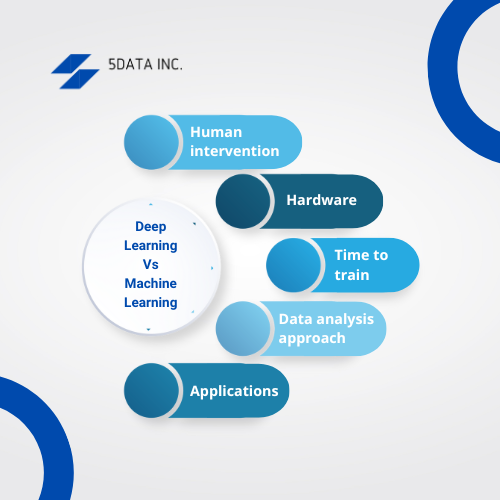Deep Learning is a subset of Machine Learning algorithms that uses an artificial neural network with multiple layers to analyze complex data patterns inspired by the human brain. The deep learning algorithm uses training data and past data points to transform input data into increasingly abstract and complex representations. It is particularly useful in image recognition, speech recognition, natural language processing, and autonomous driving. Now let us know in detail what is Machine Learning and Deep Learning
.
What Is Machine Learning?
Machine learning is a part of AI that can learn from data without explicit programming, enabling them to perform tasks continuously without human intervention. This technology is used extensively in various fields, such as finance, healthcare, art, and science.
Machine Learning finds many applications, including but not limited to Image and Speech Recognition, Predictive Analytics, Recommender Systems, Robotics, and Anomaly Detection. These tasks can be accomplished using basic decision trees and other algorithms. However, combining these algorithms with Convolutional Neural Networks, which have multiple layers and are employed in Deep Learning, further enhances their capabilities.
5Data Inc. takes pride in delivering top-notch mobile application development services and functional testing services to ensure that our products and services are of the highest quality.Machine Learning models are traditional machine learning algorithms that are classified into three main categories:
- Supervised Learning – Utilizes annotated data for forecasting
- Unsupervised Learning – trains machines on unannotated data to find patterns.
- Reinforcement Learning – trains machines to make decisions based on rewards or punishments.
Both supervised and unsupervised learning approaches have advantages and disadvantages and can be used for various tasks in machine learning. With these standard machine learning models, we can recognize cats and dogs from labeled images, identify customer transaction patterns, and teach a machine to play chess by maximizing rewards and minimizing punishments.
What Is Deep Learning?
Deep Learning (DL) is a subset of Machine Learning that involves training artificial neural networks with multiple layers to learn hierarchical representations of data. Deep Learning models consist of multiple layers of interconnected nodes that transform data into increasingly abstract and complex representations.
DL is often considered at the forefront of the machine learning model and is used in many applications, such as Netflix’s movie recommendations and streaming music services’ song suggestions. Google also employs DL in its voice and image recognition algorithms.
Deep Learning applications use an artificial neural network to imitate human learning processes, whereas traditional machine learning uses predictive models. Deep learning algorithms require large data sets and use complex mathematical calculations to ask binary true or false questions based on the data to understand data and provide accurate results.
A deep learning model is an artificial neural network that can automatically learn and improve from large amounts of data, whereas a machine learning technique still needs a human brain.
5Data Inc., the mobile application development company, leverages these computer science futuristic Machine Learning and Deep Learning concepts and creates innovative solutions to deliver optimum results.

5 Key Differences – Deep Learning Vs Machine Learning
Following are the prominent Deep Learning vs Machine Learning differences:
1. Human intervention
A Machine Learning algorithm and deep neural networks are two different approaches to machine intelligence and have distinct differences. One significant difference is that it requires human intelligence.
While the machine learning process relies on humans to hand-code the feature engineering used in data analysis, deep learning systems try to learn those features independently using neural networks.
Take facial recognition software as an example. It uses artificial neural networks in the system to progressively identify facial features from edges to entire faces. As the system trains on vast amounts of data, it becomes more proficient at accurately identifying faces without human intervention.
2. Hardware
Another difference between the two is hardware requirements. Due to the complex mathematical calculations involved in deep learning algorithms and the vast amounts of data they process, deep learning systems require more powerful hardware than machine learning systems.
Deep Learning often includes a Graphics Processing Unit (GPU), while machine learning can run on lower-end machines such as a standard Central Processing Unit (CPU). Likewise, GPUs’ high bandwidth memory and thread parallelism make them valuable for masking latency (delays) during memory transfer.
3. Time to train
Another significant difference is the time required for training. Deep learning systems require more time to train due to the massive data sets and complex tasks mathematical formulas involved. Training a deep neural network learning system can take a few hours to a few weeks, whereas machine learning techniques can take as little time as a few seconds to a few hours.
4. Data analysis approach
Additionally, the approach to data analysis differs between the two. While Machine Learning algorithms parse data in parts and combine them to develop a solution, deep learning systems look at an entire problem or scenario in one go.
Deep learning systems allow object recognition and locating them in an image in one result, whereas machine learning requires separate object detection and recognition steps. Machine Learning needs structured data, and Deep Learning uses neural networks for large volumes of unstructured data.
5. Applications
Machine learning is used for predictive programs like weather forecasts, spam identification, evidence-based treatment plans, image and speech recognition, natural language processing, and recommendation systems, to name a few. In contrast, Deep Learning is used for facial recognition, music streaming, drug discovery, and self-driving cars.
The Future Of Machine Learning And Deep Learning
Machine Learning and Deep Learning have immense potential for a wide range of applications in the future. The use of robots will undoubtedly increase not only in manufacturing but also in various ways to enhance our daily lives, both significant and minor.
Deep learning technology is expected to revolutionize how doctors detect and predict diseases such as cancer in the healthcare industry, leading to earlier diagnosis and improved patient outcomes. Similarly, in the financial sector, Machine Learning and Deep Learning have the potential to help companies and individuals save money, invest more intelligently, and manage resources more efficiently.
Conclusion
5Data Inc., the best software application development company, enables you to unleash the complete potential of your business. Our team of specialists can help you leverage AI’s power to promote growth and innovation. With intelligent automation and predictive analytics, we can streamline your operations, enhance customer experiences, and provide comprehensive data insights. Contact us today to learn how we can help you stay ahead of the curve with our cutting-edge AI solutions.

Rasmita Patro
Author
